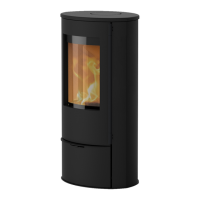9
2 Lotus stoves are suitable for intermittent burning
Multiple flue connection is possible. Consult your registered installer.
3 Technical data
Please see our technical data for Lotus stoves at the back of our user
instructions.
4 Safety clearances
Please see our technical data for Lotus stoves at the back of our user
instructions.
5 The appliance must not be modified!
Fire protection outside area of radiated heat
The minimum clearances to combustible materials and furniture shown on the
rating plate must not be exceeded.
In cases where no safety clearances need to be observed, we recommend 70
to 100 mm to allow the heat radiated by the stove to distribute freely and
enable easy cleaning behind the stove.
6 Fuel
Only use the following type of fuel in your Lotus stove:
Natural, air-dried firewood with a moisture content below 20% (optimal value
15 - 17% moisture).
6.1 Lighting the stove for the first time
Lighting the stove for the first time dries out the Senotherm coating which
causes a slight odour however this will disappear after a while. Do not touch
the stove after lighting to avoid damage and discolouration of the surface.
6.2 Fuel
6.2.1 Kindling
Use small logs (e.g. firewood about 2 x 2 cm with a length of about 25 cm) as
kindling.
6.2.2 Wood
Different types of wood are suitable for use as fuel, e.g. beech, birch, ash or
fruitwoods. Impregnated wood, chipboard, coloured leaflets or glazed paper
are not suitable for use in a Lotus stove. These give rise to the formation of
acid or heavy metal which causes the metal surfaces in the stove to rust. This
results in incomplete combustion which is harmful to the environment.
Split logs for Lotus stoves should be about 30 cm long with a diameter of 7-9
cm. Extremely important for efficient burning is the maximum moisture
content of 15-20%. Using wood that is too moist will greatly reduce the
performance of the stove because a large amount of the energy is used for
evaporation of the released water. The water vapour substantially reduces the
temperature in the stove, which can give rise to condensation in the flue pipes.
The condensation causes pitting corrosion in the flue pipe and this can also

